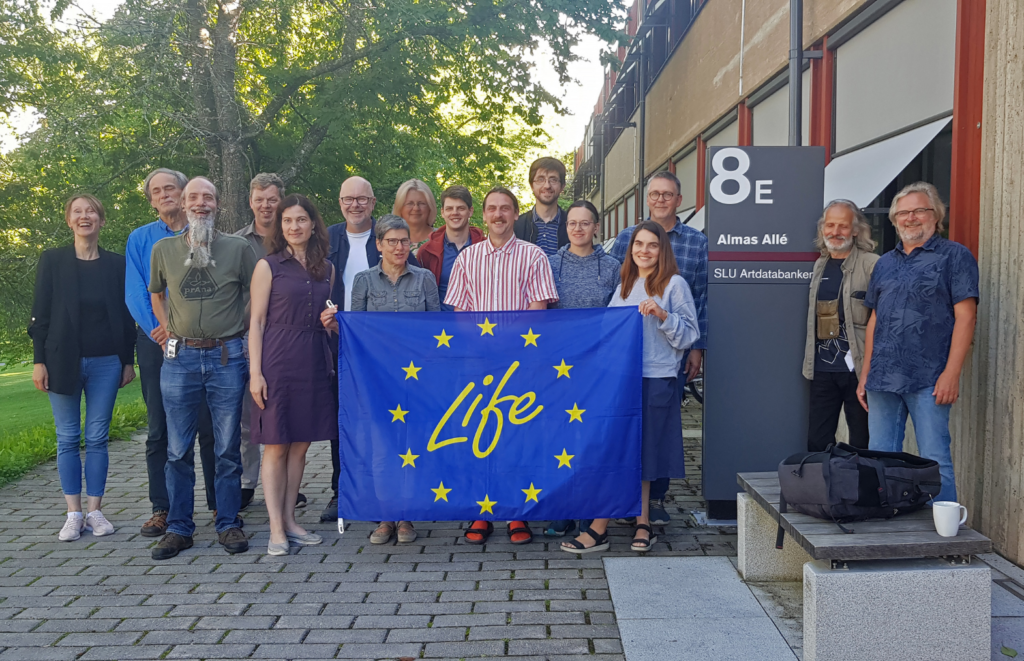Experience exchange trip to Sweden
At the end of August, LIFE for Species project team visited several LIFE projects in Sweden to share the experience of the project team, as well as to learn from representatives of the Swedish projects.
On the first day of the trip, the project team visited the Swedish Species Information Center in Uppsala, which is part of the Swedish University of Agricultural Sciences (SLU). The tasks of the information centre include the evaluation of the threat to species according to IUCN criteria, the analysis of data on the diversity of species, as well as other tasks related to the protection of species.

The head of the information center introduced the project team to the Swedish species evaluation system. The first species threat assessment in Sweden, using the methodology developed by the IUCN (International Union for Conservation of Nature), was completed in 2000 - it includes approximately 60,000 species and is renewed every five years. The last assessment was published in 2020, and it lists 22,000 species, of which around 4,700 are recognized as threatened.

During the meeting, experts from both countries shared their experiences and gave presentations on trends in the assessment of endangered species and their results. In general, changes to the list of protected species are very rare in Sweden, as it is a very complex process involving several institutions, companies and even political parties. Unlike Latvia, no "micro-sanctuaries" are created for the protection of species, but perhaps their introduction could be considered in the future.
The second day of the visit was spent meeting with representatives of two Swedish LIFE projects and visiting the locations of these projects. The first of the projects was the LIFE Bridging the Gap project, which aims to improve and restore 30 valuable oak groves in south-eastern Sweden, as well as to improve and create suitable habitats for several rare invertebrate species. They would serve as transfer points or "stepping stones" in space (i.e. between distant habitats of a species) and time (i.e. in one habitat where, due to the age structure of trees, a lack of suitable micro-habitats has been observed or expected in the future). The aforementioned solutions were discussed during the meeting during a visit to the Natura 2000 area in Tinnerö and Åtvidsnä nature reserve.

Anneli Lundgren, manager of the LIFE RestoRED project, presented the essence of this project to the representatives of LIFE for Species. Its aim is the restoration of habitats of European importance in Sweden and the promotion of populations of rare and protected species of invertebrates and lichens. To achieve this, various methods are used - reduction of spruce monoculture plantations, shading of old broad-leaved trees, mainly common oaks, planting of flowering plants, grazing of meadows, etc. In total, the project has 79 activity sites in the southern and central parts of Sweden, where it is planned to restore grasslands of EU importance in an area of approximately 11,000 ha.

On the third day of the visit, a meeting was held with Magnus Melander, representative of the Swedish LIFE project Taiga. During the meeting, several pilot territories of the LIFE Taiga project were visited, where controlled burning was carried out as part of the project, with the aim of restoring forest habitats. During the visit, the role of fire in transforming the forest and providing habitats for various species was discussed, as well as an insight into the advantages of the controlled burning method and the specifics of its use.

Controlled burning as a forest management and habitat restoration measure in Sweden is also included in the national FSC standard, and is also relatively widely used within projects, therefore there are individual service providers in Sweden who are specialized in performing such work. Often, even local government administrations have personnel trained to perform such work. In comparison, this method is practically not used in Latvia.

LIFE Taiga project ended in 2020, but the initiated activities will be continued on an even larger scale within the LIFE Taiga 2 project starting in the fall of 2022.

The networking trip was concluded with a visit to LIFE RestoRED project site "Hagebyhög". It is a Natura 2000 area, where large-scale works are planned to restore the calcareous herb marsh habitat and the Vertigo snail habitat included in the Habitats Directive. The site is bordered by a good-quality calcareous herb bog, where the management experience of this habitat type in Latvia and Sweden was discussed. It is important that various rare and protected species (various orchids, mosses, etc.) also grow and live in the swamp.
The knowledge, information and contacts established during the trip will be valuable in the further implementation of the LIFE FOR SPECIES project.
